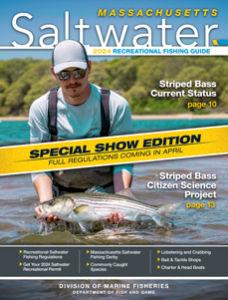Commonly Caught Species
Striped Bass
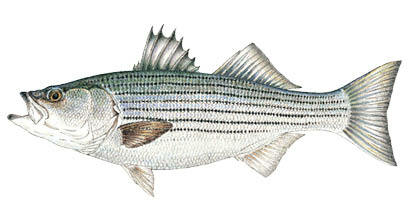
Striped bass is our most sought-after species, providing great sport through catch and release fishing and great eating when you catch a “keeper”. Striped bass is one of the largest fish available to the nearshore angler. Fish range from 1 pound to over 60 pounds.
Location: Whole coast surf, inshore bars, reefs, tide-rips, bays, and estuaries.
Season: Mid April-October
Baits and Lures: Seaworms, eels, squid, herring; jigs, plugs, spinners, spoons.
Methods and Tackle: Casting from shore, boat-trolling; light to heavy tackle.
Black Sea Bass
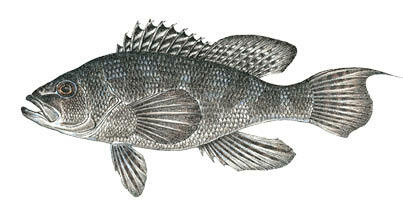
The migratory black sea bass is a tasty fish arriving in our near shore waters in the late spring. These fish also have a peculiar life cycle—the majority begin life as females and then change to males at around three years of age.
Location: South side of Cape Cod, Buzzards Bay to Rhode Island border and a few are found in Cape Cod Bay. Fish for them around bottom structure such as reefs, rocks, and wrecks.
Season: May-September
Baits and Lures: Cut squid, clams, green crabs.
Methods and Tackle: Bottom fish from a boat.
Tautog
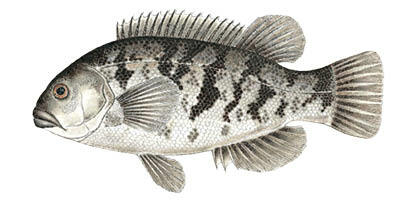
“Tog”, “white chin” and “black fish” are all common nicknames for this fish. Tautog are very slow growing compared to most fish and do not migrate far from where they originate but move inshore in the spring and offshore in the winter.
Location: Whole coast, rocky bottoms inshore, bays, harbors, jetties, breakwaters.
Season: April-November
Baits and Lures: Crabs, clams, all shellfish.
Methods and Tackle: Still-fishing from boat or shore, medium action spinning or conventional rod, 20-30 lb test line.
Bluefish
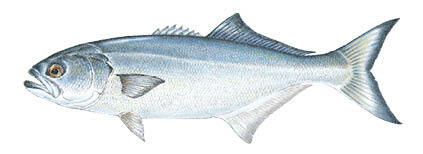
Bluefish are usually ravenous and will strike at just about anything you give them. Watch out for those teeth! They average around 3-7 pounds along the coast and tend to be larger just offshore in the rips. The juveniles, referred to as “snappers,” can be found in the estuaries and are fun to catch with light tackle. In all cases, they put up an excellent fight all the way to your boat or shore.
Location: Whole coast surf, inshore bars, tide rips, bays, and estuaries.
Season: June-mid October
Baits and Lures: All small bait fish, jigs, spoons, plugs, spinners, flies.
Methods and Tackle: Casting from shore or boat (you may want to use a wire leader) with spin and fly fishing gear, trolling.
Scup
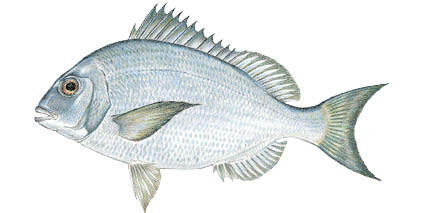
A party boat staple, scup are easy and fun to catch. Scup are very good eating though be careful of the many bones.
Location: South side of Cape Cod and along coast to Rhode Island
Season: May-October
Baits and Lures: Clams, strips of squid, seaworms.
Methods and Tackle: Light- to medium-weight tackle, drift-fishing, jetties, piers, bridges.
Weakfish (Squeteague)
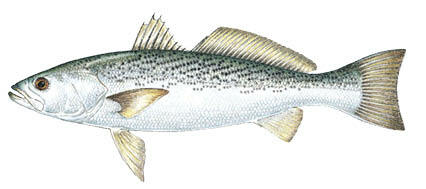
The weakfish looks like a large trout and is found in Massachusetts waters during the summer months. Often found feeding alongside striped bass.
Location: Southern Massachusetts sandbars, deep water drop offs, channels, bays and estuaries
Season: Late June-September
Baits and Lures: Shrimp, seaworms, tinker mackerel, eels, strips of squid; artificial lures (bright plastic shrimp, worms, bucktails, tubes, jigs, sand eel imitations)
Methods and Tackle: Still-fishing, drifting, chumming, casting from shore or boat, trolling; light to medium tackle.
Winter Flounder
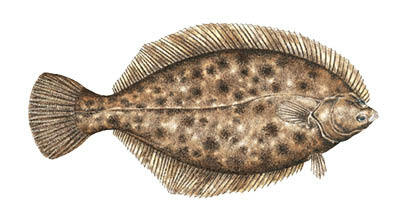
The winter flounder (black back) provides good fishing during the cold weather months. They are very accessible and provide the angler with thick fillets to take home.
Location: Whole coast, tidal streams, shallow bays, estuaries.
Season: May-February
Baits and Lures: Sandworms, bloodworms, clams, strips of squid.
Methods and Tackle: Chum pot (crushed clams), still-fishing from boats, piers, jetties, bridges, breakwaters; light tackle
Mackerel
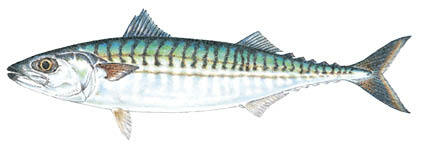
Mackerel are fast swimmers and voracious feeders, which offers the angler many options for catching them. They are also an important food fish for many other species of fish and marine mammals.
Location: Whole coast, deep water to shallow bays, beaches, jetties, canal, bridges.
Season: May-September
Baits and Lures: Small bait fish, crab, clams, seaworms, squid strips, jigs, spoons, flies.
Methods and Tackle: Trolling, jigging, casting from shore or boat: light tackle.
Bonito
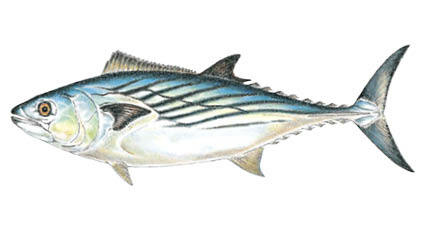
Sharpen your reflexes because these small tunas are fast and fun to catch. Watch for feeding schools where there will be jumpers. For a quick identification, look for dark bands running the length of the fish above the lateral line and a silvery belly.
Location: Southern Cape Cod and the Islands, rarely north of Cape Cod.
Season: Late July-October
Baits and Lures: Strip baits, squid, small jigs, spoons, plugs, flies.
Methods and Tackle: Spinning gear, bait casting, light boat rods, trolling, fly fishing.
Summer Flounder (Fluke)
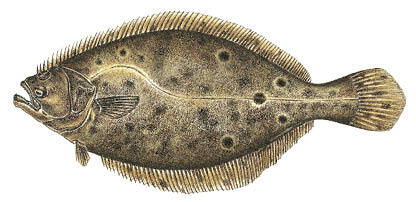
Fighting ability and fine flavor highlight this flatfish. The upper surface of the summer flounder head faces left. They also have prominent teeth to assist with their aggressive predatory behavior. Larger fluke are referred to as “doormats”. Target sandy or muddy bottom along with fast moving rips that contain debris and bait fish.
Location: South side of Cape Cod, Islands, Cape Cod Bay, Buzzards Bay.
Season: May-September
Baits and Lures: Minnows, squid strips, clams, shrimp; spinners, jigs.
Methods and Tackle: Drift-fishing, troll, chum, still fish, casting.
Tunas: Bluefin (top) and Yellowfin (below)

All the tunas are very swift swimmers, provide a thrilling and sometimes backbreaking fight and are literally hot blooded. The giant bluefin tuna is the biggest and most lucrative of the tunas in our waters and thus creates much competition amongst fishermen. Yellowfin are commonly caught in near offshore waters as are albacore.
Location: Offshore east of North Shore, Cape Cod Bay, East of Cape Cod, South of Islands, offshore in Canyons
Season: Late June-October
Baits and Lures: Bait fish used with chum slick; plastic squids, multi-squid rigs, daisy chains, jigs, artificial lures
Methods and Tackle: Trolling, chunk baits with chum; medium to heavy tackle
False Albacore (Little Tunny)
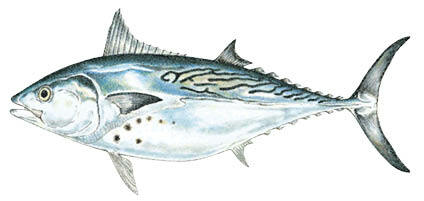
False albacore are very similar to bonito - fast, fun and sometimes a bit tricky to catch. However, unlike bonito, they make poor table fare.
Location: Mostly warmer waters of the south side of Cape Cod and the Islands.
Season: Late July-October
Baits and Lures: Same as for bonito
Methods and Tackle: Same as for bonito
Cod

Cod are the deepwater treasures of Massachusetts.
Location: Whole coast, deepwater, inshore while water is cold.
Season: Year round.
Baits and Lures: Sea worms, clams, mackerel, strips of all fish, crabs, jigs.
Methods and Tackle: Bait-fishing from shore and boats, fishing from boats using medium to stiff boat rod, conventional reel and at least 50 lb. test line.
Pollock

The pollock is more available to the angler than its codfish relative. These aggressive fighters offer the thrills of a bluefish and the flesh of a cod.
Location: Whole coast with more north of Plymouth. Inshore (breakwaters and other structures) and offshore depending on the water temperatures. Inshore, pollock tend to be smaller than those offshore.
Season: May-October with the best runs in May, October
Baits and Lures: Same as cod, plus metal lures with a strip of squid.
Methods and Tackle: Still-fishing, casting, trolling. For deep water use same set up as for cod. Lighter spinning gear can be used for inshore fishing.
Halibut

This is the largest of the Atlantic flatfishes, which if you do happen to hook one, can be very challenging to reel up from deep water.
Location: Whole coast, cool and deep waters, preferred bottom type is sand, gravel or clay not soft mud or rock.
Season: Year round
Baits and Lures: Seaworms, clams, strips of fish, sandlance, jigs.
Methods and Tackle: Fishing from a boat with medium to stiff rod.
Haddock
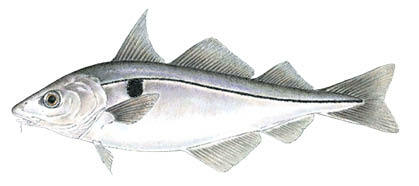
Haddock is a member of the cod family and is a delicious fish for the dinner table. The black lateral line distinguishes it from the cod and pollock.
Location: Whole coast, cool waters, prefer depths of 140-450 ft., also prefers shell/sand, smooth rock, or gravel bottom.
Season: May-November
Baits and Lures: Seaworms, clams
Methods and Tackle: Still-fishing from a boat, medium action rod
Cusk

Like the cod, the cusk is a cool water fish and is found on hard, rough bottom habitat. Look for the continuous dorsal fin to assist with identification.
Location: Rocky ledges/hard bottom, moderately deep waters (more than 75 feet).
Season: Year round.
Baits and Lures: Same as cod.
Methods and Tackle: Same as cod.
Wolffish (Ocean Catfish)
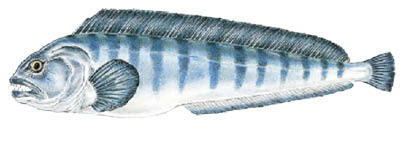
Wolfish are distinguished by their large size, pronounced molar and canine teeth, and the lack of ventral fins. They do not school and prefer hard bottom, not mud, in deep waters.
Location: Whole coast, deep water, incidental to cod fishing.
Possession Prohibited
Rainbow Smelt
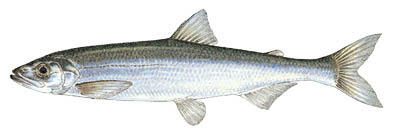
This small anadromous fish is a seasonal favorite along the coast. They’re accessible prior to the spawning runs up coastal streams during the late winter and early spring.
Location: Whole coast, estuaries, the mouths of coastal rivers, and within coastal rivers.
Season: September-February
Baits and Lures: Blood worms, sand worms, grass shrimp, small local bait fish
Methods and tackle: Ice fishing, shore fishing—keep bait moving slowly up and down within the school; light tackle, hand line.
Sharks: Shortfin Mako (top) and Blue (bottom)

Blue and mako sharks are common to our offshore waters and are sought after by recreational anglers. Makos are the more aggressive of the two fish and will put up an exciting fight. Venture with an experienced shark angler to prevent unexpected surprises and make sure you bleed and ice the shark flesh immediately. Anglers are encouraged to release sharks not intended for consumption.
Location: South of the Islands, East of Cape Cod, off North shore including Cape Cod Bay.
Season: June-October
Baits and Lures: Chumming and baited hooks (preferably oily fish)
Methods and Tackle: Trolling, drifting; medium to heavy tackle, wire leader.
Herring of Massachusetts
A variety of herring frequent MA coastal and estuarine waters and can be confusing to identify. River herring (alewife and blueback herring) and American shad are generally seen during spring spawning runs. Menhaden and Atlantic herring may appear in our estuaries during coastal migration in the summer or early fall.
Atlantic herring

Alewife

Blueback herring

American shad

Atlantic menhaden

Note: The harvest and possession of river herring (alewife and blueback) is prohibited in Massachusetts.

